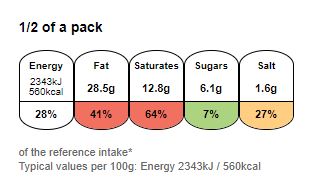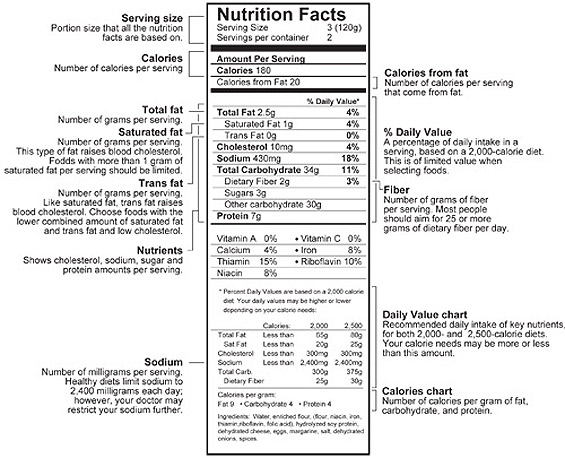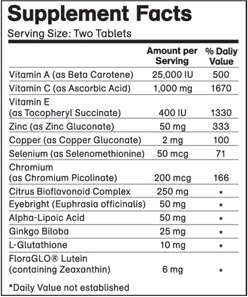40 why are serving sizes standardized on food labels
There's a Difference Between 'Portion Size' and 'Serving Size' A "portion" is defined as "the amount of food served or provided for consumption at one time". A "serving" is defined as "an amount of food or drink that constitutes an individual's basic daily requirement". For many food products, the serving size is often smaller than the portion. Sticking to these recommended servings can ... Nutrition Facts Matter: What Food Labels Mean (and Why They Changed) The size of each serving is standardized by the FDA to make it easier to compare similar foods. Pay extra attention to the serving size. This is often one of the most overlooked items on the nutrition facts label. An official serving may be smaller that you think. A "serving" is different from a "portion." A serving is a measured amount of food.
How to Understand and Use the Nutrition Facts Label | FDA Serving sizes are standardized to make it easier to compare similar foods; they are provided in familiar units, such as cups or pieces, followed by the metric amount, e.g., the number of grams (g)....

Why are serving sizes standardized on food labels
FDA Final Guidance on Nutrition Facts Label Serving Size Monday, January 6, 2020. In May 2016, FDA issued final rules changing the Nutrition Facts label for packaged foods and updating regulations on serving sizes to - among other things - provide ... Chapter 6 - Standardized Recipes - Introduction to Food ... - Unizin A good standardized recipe will include: Menu item name - the name of the given recipe that should be consistent with the name on the menu. Total Yield - number of servings, or portions that a recipe produces, and often the total weight or volume of the recipe. Portion size - amount or size of the individual portion. Definition and Importance of the Serving Size | Healthfully The United States Department of Agriculture determined that nutritional values be contained in the defined serving size. This information must be placed on food packages in the form of a Nutrition Facts label for easy access to information about the calories, fats, protein, fiber, carbohydrates, vitamins and minerals in one serving.
Why are serving sizes standardized on food labels. F.D.A. Weighs Update to Standard Serving Sizes - The New York Times On today's food packages, many of the serving sizes puzzle even the experts. ... But the calorie count refers to a one-ounce serving, and the label says the bag holds one-and-one-third servings ... Why do food labels have standardized "serving sizes" and "servings per ... Why do food labels have standardized "serving sizes" and "servings per container" listed on label? ANSWER 0 colbib ANSWERS: 1-Icy-so you know how much to eat and also tells you how many ppl can eat that amount before it is gone. you have a cup of noodles serving size is 1/3 cup than you can get 3 servings from container. helps with meal ... Serving Size on the New Nutrition Facts Label | FDA Some serving sizes have changed on the new Nutrition Facts label. By law, serving sizes must be based on the amount of food people typically consume, rather than how much they should consume.... New Nutrition Labels from the FDA Make Reading Nutrition Labels ... - Shape Credit: Food and Drug Administration Even if serving sizes might sometimes seem arbitrary, they're standardized based on what the FDA calls the reference amounts customarily consumed (RACC). Those numbers are based in part on national survey results, so they're subject to change.
Why Are Serving Sizes on Nutrition Labels So Small? The tables are intended to describe the amounts typically consumed in a serving, but the FDA determined these figures before Americans began eating more fatty, sugary, and salty foods. Notice... 'Portion Size' and 'Serving Size' Are Not the Same: Why It Matters "Serving size" is based on a standardized amount of food or drink which is established by research done on the eating habits of adults and children. Understanding the difference between portion... Food Label Flashcards | Quizlet Serving Size and serving per container Serving sizes are supposed to be standardized to reflect the amt of food people actually eat, but sometimes they are quite unrealistic. How to find out calories # of calories x servings per container 90 x 4 = 360 calories How to find percent of calories from fat calories from fat / calories 30 / 90 = .33 = 33% IFIC Study Serves Up Reality Check on Serving, Portion Sizes The ways people control their portion sizes vary: Similar numbers said they try to eat more slowly (34%), stop eating once they feel full, even if there's still food on their plate (34%), use ...
What's the Difference Between Portion and Serving Sizes But out of those claiming at least some understanding of portion sizes, the most popular definition ("a standardized amount typically consumed") was the same as the serving size — identical at 48% — indicating that consumers essentially conflate the two terms. Slightly behind, 45% correctly identified it as the amount one chooses to ... Who Decides Serving Sizes? | HuffPost Life A serving size is a measurement that allows food manufacturers to create accurate and uniform nutrition labels across brands. It is not a prescriptive size that relates to health. Serving Size vs Portion Size Is There a Difference Serving size is a standardized amount of food. It may be used to quantify recommended amounts, as is the case with the MyPlate food groups, or represent quantities that people typically consume on a Nutrition Facts label. Portion size is the amount of a food you choose to eat — which may be more or less than a serving. PDF Understanding Portion and Serving Sizes - Food Insight Serving sizes appear on the Nutrition Facts label and sometimes on the front of food packaging, and they are used to calculate the nutrient information displayed on the label (such as calories, totalfat or dietary fiber per serving). Refer to this image of a Nutrition Facts label as an example.

New Nutrition Facts labels will list calories more clearly and serving sizes more prominently ...
Differences between EU and US nutrition labels go far beyond ounces and ... In the US, nutritional labels must indicate the number of servings per container - so calories are broken down based on how many slices of bread come in a package, or how many 12-chip portions a...
IFIC Study Serves Up Reality Check on Serving, Portion Sizes "Helping to control weight" ranked in the top two reasons for 36%, followed by "helping to avoid eating too much of certain foods" (30%) and "helping to know how much they should be eating or drinking" (26%). Sizing Up the Terms: Portion Control

30 When Reading The Food Label, The Serving Size Determines The Basis For The Food's Nutrient ...
Portion Size Versus Serving Size | American Heart Association Serving Size is the amount of food listed on a product's Nutrition Facts label. So all of the nutritional values you see on the label are for the serving size the manufacturer suggests on the package. Once we understand the difference, it's easier to determine how much to serve and easier to teach kids the difference between the two. ...
The Importance of Reading the Food Label and Nutritional Facts Going forward, the serving sizes must be based on what people are actually eating, not what they should be eating. And for packages that are between one and two servings, the rest of the caloric and nutritional information must be labeled as a single serving since people tend to consume these size packages in one sitting.
More Realistic -- Serving Sizes for Food Labels - HuffPost FDA Proposes Larger -- More Realistic -- Serving Sizes for Food Labels The FDA is proposing to change the standard serving sizes to reflect what people actually eat. The FDA defines the current serving sizes as amounts of foods commonly consumed based on dietary intake surveys conducted in the 1970s and 1980s. By Dr. Lisa Young, Contributor

Can anyone tell me how many chicken tenderloins =4 oz | Nutrition labels, Food portions, Healthy
Serving and Portion Sizes Explained - Lark Serving sizes are standard amounts of food. The Academy of Nutrition and Dietetics explains that they are the amounts of food that you may see on a nutrition facts panel. And they can be the amounts you see when you are looking at recommendations for daily intake. Portion sizes are the amounts of food that are served or eaten.
Serving Size vs. Portion Size, What's the Difference? - Prevention A serving size is defined as a standardized, measured amount of food. This is most commonly used by the United States Department of Agriculture (USDA) in reference to food groups or printed on...
The Difference Between 'Portion Size' and 'Serving Size' (and Why It ... It's true that understanding serving sizes helps you make sense of food labels, so that you can get a more accurate sense of the nutritional makeup of your food depending on how many servings you...
Consumer Survey: Understanding Portion and Serving Sizes - Food Insight Regardless of food or beverage category, about half say they try to eat close to the serving size listed on packaging. The top-ranked reasons for paying attention to portion sizes are to help control weight (36% ranked in top 2) and to help avoid eating too much of certain foods (30%).
How To Read A Nutrition Facts Label - Insports Trumbull, CT - Adult & Youth Leagues - Soccer ...
FDA Food Product Labeling & Packaging Requirements | ESHA Research Food Product Labeling and Packaging 101. The FDA regulates most packaged foods sold in the United States and has specific requirements for what elements a package must contain (e.g. a Nutrition Facts panel, ingredient statement, etc.). In order to sell your food products, you must comply with the FDA's packaging laws unless your operation is ...
Definition and Importance of the Serving Size | Healthfully The United States Department of Agriculture determined that nutritional values be contained in the defined serving size. This information must be placed on food packages in the form of a Nutrition Facts label for easy access to information about the calories, fats, protein, fiber, carbohydrates, vitamins and minerals in one serving.
Chapter 6 - Standardized Recipes - Introduction to Food ... - Unizin A good standardized recipe will include: Menu item name - the name of the given recipe that should be consistent with the name on the menu. Total Yield - number of servings, or portions that a recipe produces, and often the total weight or volume of the recipe. Portion size - amount or size of the individual portion.

The serving size conundrum: Updated serving sizes on food labels will reflect how much we really ...
FDA Final Guidance on Nutrition Facts Label Serving Size Monday, January 6, 2020. In May 2016, FDA issued final rules changing the Nutrition Facts label for packaged foods and updating regulations on serving sizes to - among other things - provide ...

TIL that the serving sizes on food labels in the US are not the recommended healthy portion ...

Serving size examples (for Food Label interactive suggestion) (With images) | Food labels ...

New food labels compare nutrition facts in one serving size versus the whole package | KTVL

45 best images about Serving Sizes & Food labels on Pinterest | Healthy, Portion sizes and For ...

New food labels compare nutrition facts in one serving size versus the whole package | KOMO




















Post a Comment for "40 why are serving sizes standardized on food labels"